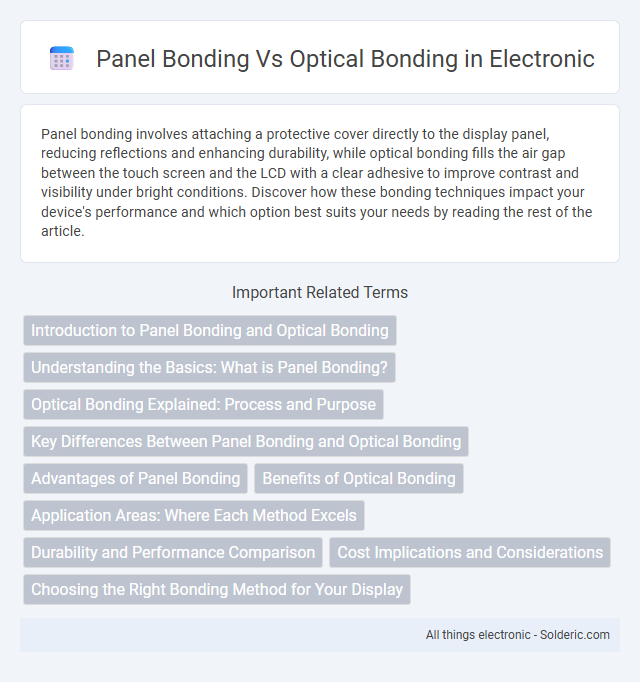Panel bonding involves attaching a protective cover directly to the display panel, reducing reflections and enhancing durability, while optical bonding fills the air gap between the touch screen and the LCD with a clear adhesive to improve contrast and visibility under bright conditions. Discover how these bonding techniques impact your device's performance and which option best suits your needs by reading the rest of the article.
Comparison Table
| Feature | Panel Bonding | Optical Bonding |
|---|---|---|
| Definition | Bonding the touch panel directly to the LCD screen | Bonding a protective glass or touch panel to the LCD using optical-grade adhesive |
| Purpose | Improves durability and reduces internal reflection | Eliminates air gap, enhances readability and ruggedness |
| Reflection Reduction | Somewhat effective | Highly effective due to air gap removal |
| Visibility in Sunlight | Moderate improvement | Significant enhancement |
| Durability | Enhanced panel protection | Maximum protection against impact and moisture |
| Cost | Lower cost | Higher cost due to materials and process |
| Use Cases | Standard industrial and commercial displays | Outdoor, rugged, and military-grade displays |
Introduction to Panel Bonding and Optical Bonding
Panel bonding involves laminating the display panel directly to the cover glass using an optically clear adhesive, reducing internal reflections and improving durability. Optical bonding uses a specialized resin to fill the air gap between the touchscreen and display, enhancing visibility and resistance to environmental factors. Both techniques significantly improve screen clarity, touch responsiveness, and device longevity in various applications.
Understanding the Basics: What is Panel Bonding?
Panel bonding is a display enhancement technique where a layer of adhesive is applied between the display panel and the cover glass to eliminate air gaps and improve touch sensitivity. This process reduces internal reflections, increasing brightness and contrast for better visibility in various lighting conditions. Understanding panel bonding helps you make informed decisions about display durability and performance in your devices.
Optical Bonding Explained: Process and Purpose
Optical bonding involves laminating a protective cover glass directly onto a display using an optical-grade adhesive, eliminating the air gap between layers to enhance visibility and reduce reflections. This process improves durability and touchscreen responsiveness by preventing dust and moisture ingress while increasing contrast and readability in bright environments. Your device benefits from improved outdoor performance and a more vibrant visual experience through optical bonding compared to traditional panel bonding, which typically leaves an air gap.
Key Differences Between Panel Bonding and Optical Bonding
Panel bonding involves laminating a protective glass directly to the display panel, eliminating the air gap to reduce internal reflections and improve durability. Optical bonding uses an optically clear adhesive between the display and the cover glass, enhancing contrast, readability, and resistance to moisture and dust. The key differences include the bonding method, material types, and optical performance improvements, with optical bonding providing superior visibility and ruggedness in outdoor or harsh environments.
Advantages of Panel Bonding
Panel bonding enhances display durability by eliminating the air gap between the LCD and the cover glass, reducing internal reflections and improving brightness and contrast. This technology offers better touch sensitivity and lowers the risk of dust or moisture ingress, extending the display's lifespan. By improving optical clarity and reducing parallax errors, panel bonding significantly enhances the overall user experience in various applications.
Benefits of Optical Bonding
Optical bonding improves display clarity by eliminating the air gap between the LCD and the touchscreen, enhancing contrast and reducing reflections for better visibility in bright environments. This technology also increases display durability by protecting against dust, moisture, and mechanical shocks, extending the lifespan of your device. Enhanced touch sensitivity and reduced parallax effects make optical bonding ideal for applications requiring precise touch response and superior visual performance.
Application Areas: Where Each Method Excels
Panel bonding excels in applications requiring cost-effective display durability and improved moisture resistance, making it ideal for outdoor signage, kiosks, and industrial monitors. Optical bonding is preferred in high-performance environments needing enhanced readability, touch sensitivity, and ruggedness, such as medical devices, military equipment, and aerospace displays. Your choice depends on balancing budget constraints with the need for superior visibility and environmental protection.
Durability and Performance Comparison
Panel bonding enhances durability by filling the gap between the display and touch panel with optical adhesive, reducing internal reflection and improving mechanical strength. Optical bonding further increases durability and performance by eliminating air gaps, which prevents condensation and dust ingress while providing better sunlight readability and touch responsiveness. Understanding these differences helps you choose the best bonding method for long-lasting, high-performance touchscreen displays in various environmental conditions.
Cost Implications and Considerations
Panel bonding typically offers a lower initial cost compared to optical bonding, as it involves bonding the LCD panel directly to the cover glass without additional layers. Optical bonding, while more expensive due to the inclusion of optical-grade adhesives that reduce reflections and improve durability, provides long-term value by enhancing display performance and reducing maintenance costs. Your decision should weigh the upfront expenses against benefits like improved visibility in bright environments and increased ruggedness.
Choosing the Right Bonding Method for Your Display
Choosing the right bonding method for your display involves evaluating environmental conditions and performance requirements, where optical bonding offers superior durability, enhanced contrast, and reduced reflection ideal for outdoor or high-ambient-light settings. Panel bonding, often used to improve ruggedness and reduce bezel gaps, is suitable for cost-sensitive applications with moderate performance needs. Assess factors such as display clarity, touch sensitivity, and exposure to dust or moisture to determine whether optical or panel bonding aligns best with your operational demands.
Panel Bonding vs Optical Bonding Infographic

 solderic.com
solderic.com